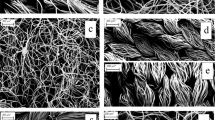Abstract
This report is directed toward the application of radiotracers to larger-scale, practical launder-ing experiments with the use of washing machines and Tergotometers with fully built detergents. Such applications have not been widely reported because of the difficulty in setting up the experi-ments, in handling the large numbers of samples which are generated, and performing the many computations. A brief description of the useful properties ofbeta-emitting radioisotopes is presented, followed by a discussion of the effect of these properties on two methods of detection; geiger and liquid scintillation counting. The advantages and limita-tions of each are described, which lead to the con-clusion that, for fabric analysis, liquid scintilla-tion counting is preferred. The combination of the modern liquid scintillation counter with a computer provides a highly efficient analytical scheme for the analysis of fabrics containing labeled species. The severe problem of radiochemical purity, which has long hampered radiotracer experiments, is next discussed together with some recommenda-tions for overcoming the problem. Finally, the applications of tagged compounds to two aspects of fabric washing are described. The first is a study of adsorptivity and rinsability of some anionic surfactants on cotton fabric after laun-dering in an automatic washing machine. The second is some results of a continuing study of detergency by using a multicomponent, double-labeled radioactive soil.
Similar content being viewed by others
References
Harris J C and W. H. Yanko, ASTM Bulletin158, 49 (1949).
Ashcraft, E. B., ASTM Special Technical Bulletin215, 30 (1956).
Hensley, J. W., and C. G. Inks, ASTM Special Technical Bulletin268, 27 (1959).
Meader A. L. Jr., and B. A. Fries, Ind. Eng. Chem.44, 1636 (1952).
Lambert, J. M., J. H. Roecker, J. J. Pescatore, G. Segura and S. Stigman, Nucleonics12, No. 2, 40 (1954).
Wagg R E., and C. J. Britt, J. Textile Inst. Trans.53, T 205 (1962).
Fort, T. Jr., H. R. Billica and T. H. Grindstaff, Textile Res. J.36, 99 (1966).
Gordon B. E., G. A. Gillies, W. T. Shebs, G. M. Hartwig and G. R. Edwards, JAOCS43, 232 (1966).
Gordon, B. E., W. T. Shebs, D. H. Lee and R. U. Bonnar, Ibid.43, 525 (1966).
Gordon, B. E., J. Roddewig and W. T. Shebs, Ibid.44, 289 (1967).
Gordon, B. E., W. T. Shebs and R. U. Bonnar, Ibid.44, 711 (1967).
Bailie, L. A., Int. J. Appl. Radiation and Isotopes8, 1 (1960).
Muhs, M. A., E. L. Bastin and B. E. Gordon, Ibid.16, 537 (1965).
Kokes, R. J., H. Tobin and P. H. Emmett, J. Am. Chem. Soc. 77, 5860 (1953).
Wolfgang, R., and F. S. Rowland, Anal. Chem.30, 903 (1958).
Alvrens, E. H. Jr., J. Lipid Res. 7, No. 2, Editorial, March (1966).
Author information
Authors and Affiliations
About this article
Cite this article
Gordon, B.E. Radiotracers in fabric-washing studies. J Am Oil Chem Soc 45, 367–373 (1968). https://doi.org/10.1007/BF02667112
Issue Date:
DOI: https://doi.org/10.1007/BF02667112




